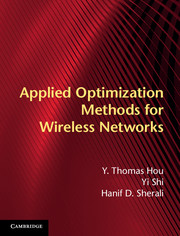Book contents
- Frontmatter
- Dedication
- Contents
- Preface
- Acknowledgments
- Copyright Permissions
- 1 Introduction
- Part I Methods for Optimal Solutions
- Part II Methods for Near-optimal and Approximation Solutions
- 5 Branch-and-bound framework and application
- 6 Reformulation-Linearization Technique and applications
- 7 Linear approximation
- 8 Approximation algorithm and its applications – Part 1
- 9 Approximation algorithm and its applications – Part 2
- Part III Methods for Efficient Heuristic Solutions
- Part IV Other Topics
- References
- Index
9 - Approximation algorithm and its applications – Part 2
from Part II - Methods for Near-optimal and Approximation Solutions
Published online by Cambridge University Press: 05 May 2014
- Frontmatter
- Dedication
- Contents
- Preface
- Acknowledgments
- Copyright Permissions
- 1 Introduction
- Part I Methods for Optimal Solutions
- Part II Methods for Near-optimal and Approximation Solutions
- 5 Branch-and-bound framework and application
- 6 Reformulation-Linearization Technique and applications
- 7 Linear approximation
- 8 Approximation algorithm and its applications – Part 1
- 9 Approximation algorithm and its applications – Part 2
- Part III Methods for Efficient Heuristic Solutions
- Part IV Other Topics
- References
- Index
Summary
It is not length of life, but depth of life.
Ralph Waldo EmersonIntroduction
This chapter is a sequel to the last chapter. In the last chapter, we showed how to design a (1 − ∊)-optimal approximation algorithm for a base station placement problem. The final solution gives a point (or any point within the corresponding fictitious cost point (FCP) subarea) for the base station. In this chapter, we extend the base station placement problem to the next level, where the base station is allowed to move around in the wireless sensor network (WSN).
The benefits of using a mobile base station to prolong sensor network lifetime are easy to understand. Since the base station is the sink node for data collected by all the sensor nodes in the network, the set of sensor nodes near the base station would carry a considerable burden in relaying traffic from other sensor nodes to the base station. By allowing the base station to be mobile, we could alleviate the traffic burden from this fixed set of sensor nodes to other sensor nodes in the network, and thus extend network lifetime. Further, given new advances in unmanned autonomous vehicle (UAV) and customized robotics, having an unmanned vehicle carrying a base station for sensor data collection may not be too far from reality. Although the potential benefit of using a mobile base station to prolong sensor network lifetime is significant, the technical difficulty of this optimization problem is enormous.
- Type
- Chapter
- Information
- Applied Optimization Methods for Wireless Networks , pp. 211 - 242Publisher: Cambridge University PressPrint publication year: 2014



